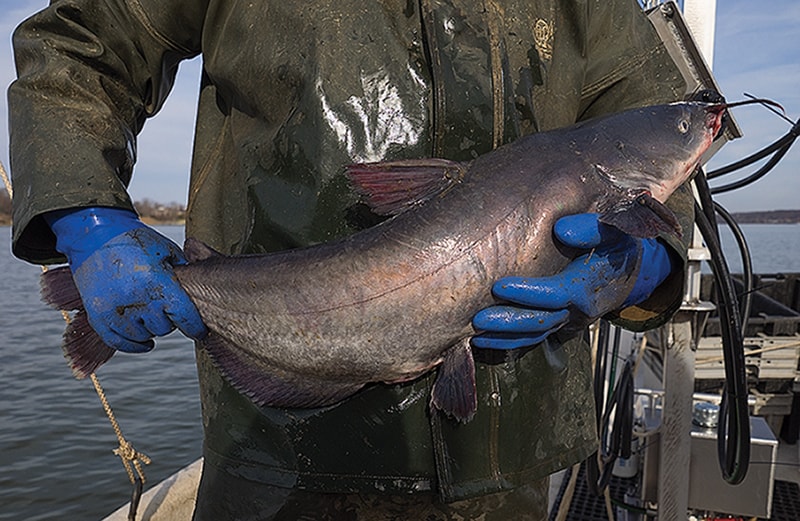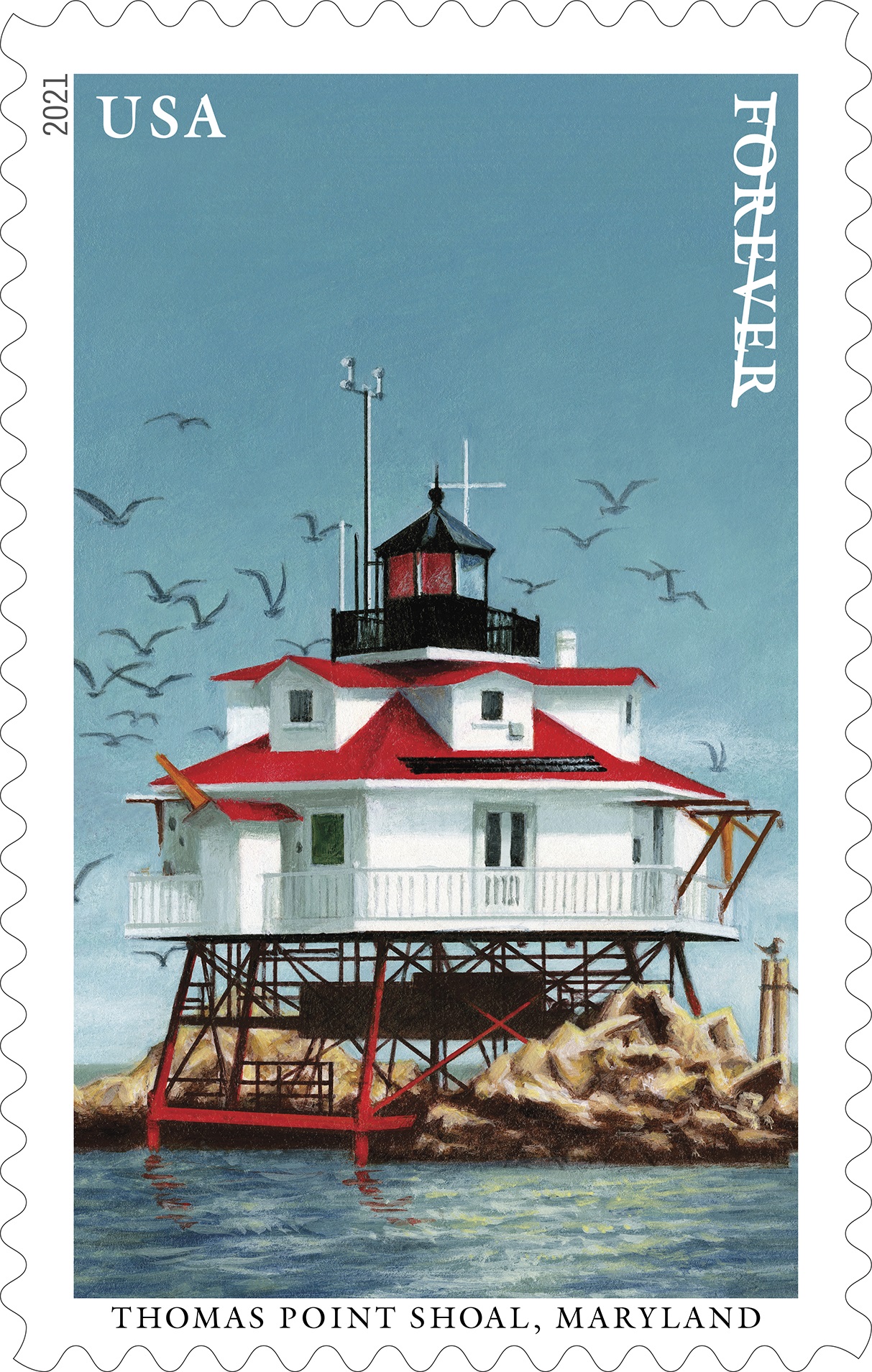Chesapeake Bay watermen and processors who handle blue catfish — an invader eating its way through the Potomac and several other major river systems—may face a less burdensome federal inspection process than they expected when a long-anticipated regulation goes into effect.
Dave Harp/ Bay JournalAs of Sept. 1, the U.S. Department of Agriculture is responsible for inspecting all catfish. The regulation covers both the wild-caught marauder menacing the Chesapeake’s tributaries and the farm-raised varieties grown in Mississippi River ponds and imported from China and Vietnam. Previously, the Food and Drug Administration inspected all fish. The FDA will continue to inspect all other fish; only catfish will be added to the USDA’s mainstays, beef and chicken.
The USDA had previously said it would require an inspector at the processors any time blue catfish were on the premises, and that the agency would cover the cost of an inspector for only 40 hours a week, and just during normal daytime working hours. Processors would have to pay about $70 per hour for inspectors needed at other times—which would be likely, as watermen bring in catfish on weekends and from early in the morning until late at night.
But after meetings with watermen, processors and fish-cutters over the last several months, the USDA has revised its plan, according to spokeswoman Julie Schwartz. Calling it an adjustment in production coverage, she said that rather than require an inspector be on hand at all times during catfish processing, the regulation will mandate an inspector only “once per production shift.” This would apply to both whole fish sellers and those that process them into filets. She did not specify the length of a shift.
Martin Gary, executive secretary of the Potomac River Fisheries Commission, helped to organize two meetings with anxious watermen and processors this summer as well as tours of two facilities, Reliant Fish Company in Jessup, Md., and ProFish Ltd. in Washington, D.C. He said he’s grateful that USDA inspectors are willing to listen to concerns, but pointed out “they haven’t guaranteed anything.”
“[What] I heard from the USDA [was] an earnest effort to try to understand the logistics, timing and challenges of the processors,” Gary said. “We don’t really have a choice, but at least there’s been some positive communications, and the two sides understand each other better.”
Introduced into the James and Rappahannock rivers in the 1970s as a new species for recreational fishermen, the whiskered blue catfish has munched its way across the Chesapeake. It now accounts for 75 percent of the biomass in parts of those two rivers, according to the National Oceanic and Atmospheric Association. Voracious and salt-tolerant, the blue catfish is also established in the Potomac and York rivers. They can grow to more than 100 pounds; devour crabs, herring and striped bass; and live for 20 years or more.
With few options to combat their spread, the Chesapeake Bay Program’s Invasive Blue Catfish Task Force in 2014 recommended establishing a commercial fishery. One quickly emerged.
In 2016, watermen caught 1.5 million pounds of blue catfish from the Potomac, up from 608,874 pounds in 2008, the year the whiskered invader first surpassed striped bass. In as little as a year or two, harvests doubled in Virginia and Maryland.
But in 2008, U.S. Sen. Thad Cochran (R-MS) slid a provision into the U.S. Farm Bill moving inspection responsibility to the USDA after a phase-in period to give agencies time to adjust. The shift was intended to protect Mississippi catfish farmers, who were complaining about competition from their counterparts in Vietnam. The regulation had critics — from Cochran’s fellow lawmakers, including Republicans, who called it an unfair trade barrier—to the Government Accountability Office, which said it was a waste of $14 million annually in taxpayer funds. Efforts to block the law faltered, and it took effect this year.
Gavin Gibbons of the National Fisheries Institute, who represents catfish processors and farms, said the provision means one of the country’s most successful “eat-the-invasives” programs will suffer.
“Maryland and Virginia have done an excellent job of creating a commercial fishery out of an invasive species, and now they will be exposed to duplicative and expensive regulations that are completely unnecessary,” he said.
NOAA’s Bruce Vogt agrees. “We felt like we were on the cusp,” of managing the blue cat fishery, he said. “That’s the trajectory we were on, and the inspections could take us off that track. The USDA has never really dealt with a fish before, a wild-caught fish, let alone an invasive species. So it’s taking a bit of learning on everyone’s part.”
Ricky Nixon, owner of Murray L. Nixon Fishery in Edenton, NC, is not reassured. His family has been in the fish-cutting business since the 1950s. His 49 employees cut 3.5 million pounds of catfish each year, much of it from the Chesapeake Bay. Already, he said, he has reduced work shifts from 10 hours to eight in anticipation of the USDA’s 40-hour work week and its rule that inspectors had to be on the premises whenever fish were cut.
“It worries the hell out of me, excuse my French. I reckon it will put the wild [catfish] people like us out of business,” Nixon said. “And there ain’t nothing I can do about it. I have cussed, I have fussed, I have done everything I can do.”
If Nixon stops handling catfish, it will be a loss of several million dollars and dozens of fishermen out of work, said Tim Sughrue, vice president of Congressional Seafood in Jessup. It’s not just the fish inspecting, he said, but also the facilities. Congressional moved into a new $9 million facility. But other processors, like Nixon’s and the two that the USDA visited, are older.
“They will stop production for a crack in the floor,” Sughrue said of federal agriculture inspectors.
Processors and watermen are working with the USDA, but also lobbying for change. They have formed an organization, the Wild American Catfish Coalition. The effort has included letters to U.S. Agriculture Secretary Sonny Perdue asking for wild catfish to be exempted from the law. They are from Maryland Gov. Larry Hogan; Basil Gooden, Virginia secretary of agriculture and forestry; and Robert Newberry of the Delmarva Fisheries Association.
Hogan, in addition, asked for a six-month delay in enforcing the law, saying the extra time will allow the state to fully assess business’ harm from the regulation. Hogan spokeswoman Amelia Chasse said the governor’s staff plans to meet with Congressional staff to pursue the issue.
USDA spokeswoman Schwartz and other department officials have maintained the department is only doing what Congress mandated. Advocates want to remedy that with new legislation or an exemption in the next Farm Bill, which is due by September 2018.
The Potomac fisheries commission’s Gary hopes that lawmakers ultimately will agree that the best way to deal with a Chesapeake Bay menace is to let fishermen take as many as they can, with minimal red tape, while offering consumers a healthy, plentiful and relatively inexpensive protein source.
“At the end of the day, it comes down to the resource,” he said, “or it’s supposed to anyway.”
-Rona Kobell, Bay Journal News Service




